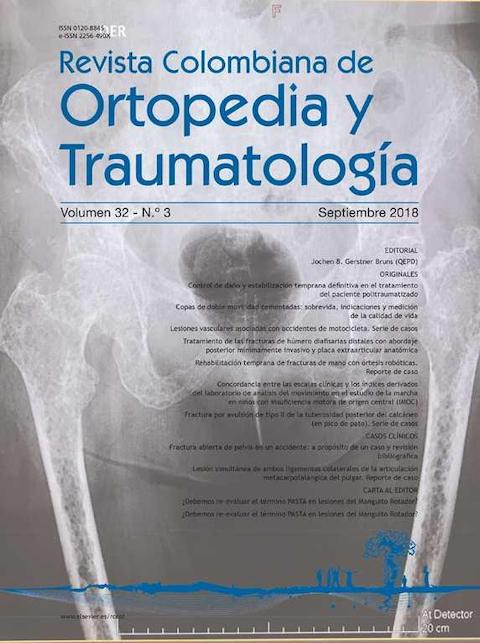Copas de doble movilidad cementadas: sobrevida, indicaciones y medición de la calidad de vida
DOI:
https://doi.org/10.1016/j.rccot.2017.11.007Palabras clave:
remplazo total de cadera, prótesis de cadera, osteoartrosis, fractura de cadera, calidad de vidaResumen
Introducción: Las copas de doble movilidad son implantes en que se introduce una cabeza protésica en un núcleo de polietileno, el cual posteriormente se articula con una copa metálica implantada en el acetábulo. Este tipo de diseño desarrollado en Francia desde la década de 1970 ha demostrado disminuir el riesgo de luxación en un remplazo total de cadera. Estas copas han sido utilizadas históricamente de forma no cementada. No obstante, actualmente se pueden utilizar copas cementadas. Los objetivos de este estudio son determinar la sobrevida de las copas de doble movilidad cementadas y medir la calidad de vida de los pacientes.
Materiales y métodos: Se realiza un estudio multicéntrico retrospectivo, cuya indicación para la cirugía sea fracturas (61,5%), artrosis (34,6%) o tumores (3,8%). El análisis se realizó con los pacientes operados entre los años 2011-2013 y se encontraron 82 caderas operadas con copas de doble movilidad cementadas con un promedio de edad de 76 años.
Resultados: Se revisó una copa de doble movilidad por infección; por tanto, se obtuvo una sobrevida del 97,6% con un promedio de tiempo de seguimiento de 33,7 (29,7-37,7) meses con un IC 95%, y un promedio en la escala de Oxford de 38,2 (34,8-41,7) con un IC 95%.
Discusión: Se pudo concluir que la tasa de sobrevida es óptima para el tiempo de seguimiento y el puntaje promedio en la escala de Oxford es bueno si se tienen en cuenta las comorbilidades y la media de edad de los pacientes.
Nivel de evidencia clínica. Nivel IV.
Descargas
Referencias bibliográficas
De Martino I, Konstantinos Triantafyllopoulos G, Sculco PK, Thomas PS. Dual mobility in total hip arthroplasty. Orthop Clin North Am. 2014;45:1. https://doi.org/10.1016/j.ocl.2013.08.004
Stroh DA, Naziri Q, Mont MA. Dual - mobility bearings: a review of the literature. Expert Rev Med Devices. 2012;9:23-31. https://doi.org/10.1586/erd.11.57
Wegrzyn J, Tebaa E, Jacquel A, Carret J, Béjui-hugues J, Pibarot V. Can dual mobility cups prevent dislocation in all situations after revision total hip arthroplasty? J Arthroplasty. 2015;30:631-40. https://doi.org/10.1016/j.arth.2014.10.034
Helse Bergen HF. Department of Orthopaedic Surgery Haukeland Hospital University. Norwegian National Advisory Unit on Arthroplasty and Hip Fractures. Bergen. 2015:273.
Bozic KJ, Kurtz SM, Lau E, Ong K, Vail TP, Berry DJ. The epidemiology of revision total hip arthroplasty in the United States. J Bone Joint Surg Am. 2009;91:128-33. https://doi.org/10.2106/JBJS.H.00155
Graves SE, Davidson D, Ingerson L, Ryan P, Griffith EC, McDermott BFJ, et al. Hip and Knee Arthroplasty Annual Report - National Joint Registry. Aust Orthop Assoc. 2011;180: 217.
Leonardsson O, Rogmark C, Kärrholm J, Akesson K, Garellick G. Outcome after primary and secondary replacement for subcapital fracture of the hip in 10 264 patients. J Bone Joint Surg Br. 2009;91:595-600, https://doi.org/10.1302/0301-620X.91B5.22224
Chairman MP, Tucker K, Beaumont R, Young E, Forsyth O, Swanson M. National Joint Registry N.J.R. annual 2012 report 9th Annual Report. 2012;12:1450.
Grazioli A, Ek ETH, Rüdiger HA. Biomechanical concept and clinical outcome of dual mobility cups. Int Orthop. 2012;36:2411-8. https://doi.org/10.1007/s00264-012-1678-3
Goyal N, Tripathy MS, Parvizi J. Modern dual mobility cups for total hip arthroplasty. Surg Technol Int. 2011;21:227-32.
Bauchu P, Bonnard O, Cypres A, Fiquet A, Girardin P, Noyer D. The dual - mobility POLARCUP: first results from a multicenter study. Orthopedics. 2008 Dec;31.(12 SSuppl 2):orthosupersite.com/view.asp?rID=37180.
Epinette J, Béracassat R, Tracol P, Pagazani G, Vandenbussche E. Are modern dual mobility cups a valuable opt ion in reducing instability after primary hip arthroplasty, even in younger patients? J Arthroplasty. 2014;29:8-1323. https://doi.org/10.1016/j.arth.2013.12.011
Fabry C, Langlois J, Hamadouche M, Bader R. Intra-prosthetic dislocation of dual-mobility cups after total hip arthroplasty: potential causes from a clinical and biomechanical perspective. Int Orthop. 2015;40:901-6. https://doi.org/10.1007/s00264-015-3000-714.
Philippot R, Camilleri JP, Boyer B, Adam P, Farizon F. The use of a dual-articulation acetabular cup system to prevent dislocation after primary total hip arthroplasty: Analysis of 384 cases at a mean follow - up of 15 years. Int Orthop. 2009;33: 927-32. https://doi.org/10.1007/s00264-008-0589-9
Langlais FL, Ropars M, Gaucher F, Musset T, Chaix O. Dual mobility cemented cup s have low dislocation rates in THA revisions. Clin Orthop Relat Res. 2008;466:389-95. https://doi.org/10.1007/s11999-007-0047-9
Adam P, Philippe R, Ehlinger M, Roche O, Bonnomet F, Molé D, et al. Dual mobility cups hip arthroplasty as a treatment for displaced fracture of the femoral neck in the elderly. A prospective, systematic, multicenter study with specific focus on postoperative dislocation. Orthop Traumatol Surg. 2012;98:296-300. https://doi.org/10.1016/j.otsr.2012.01.005
Wasielewski RC, Cooperstein LA, Kruger MP, Rubash HE. Acetabular anatomy and the transacetabular fixation of screws in total hip arthroplasty. J Bone Joint Surg. 1990;72: 501-8. https://doi.org/10.2106/00004623-199072040-0000518.
Murray DW, Fitzpatrick R, Rogers K, Pandit H, Beard DJ, Carra J, et al. The use of the Oxford hip and knee scores. J Bone Joint Surg. 2007;89:1010-4. https://doi.org/10.1302/0301-620X.89B8.19424
Dawson J, Fitzpatrick R, Carr A, Murray D. Questionnaire on the perceptions of patients about total hip replacement. J Bone Joint Surg Br. 2015;78-B:185-90. https://doi.org/10.1302/0301-620X.78B2.0780185
Philippot R, Farizon F, Camilleri JP, Boyer B, Derhi G, Bonnan J, et al. Survival of cementless dual mobility socket with a mean 17 years follow - up. Rev Chir Orthop Reparatrice Appar Mot. 2008;94:23-7. https://doi.org/10.1016/j.rco.2007.10.013
Prudhon JL, Ferreira A, Verdier R. Dual mobility cup: Dislocation rate and survivorship at ten years of follow - up. Int Orthop. 2013;37:2345-50. https://doi.org/10.1007/s00264-013-2067-2
Matsen Ko LJ, Pollag KE, Yoo JY, Sharkey PF. Serum metal ion levels following total hip arthroplasty with modular dual mobility components. J Arthroplasty. 2016;31:186-9. https://doi.org/10.1016/j.arth.2015.07.035
Bremner BRB, Goetz DD, Callaghan JJ, Capello WN, Johnston RC. Use of constrained acetabular components for hip instability: An average 10 - year follow - up study. J Arthroplasty. 2003;18 Supl 1:131-7. https://doi.org/10.1016/S0883-5403(03)00295-X
Callaghan JJ, O'Rourke MR, Goetz DD, Lewallen DG, Johnston RC, Capello WN. Use of a constrained tripolar acetabular liner to treat intraoperative instability and postoperative dislocation after total hip arthroplasty: a review of our experience. Clin Orthop Relat Res. 2004:117-23. https://doi.org/10.1097/01.blo.0000150276.98701.95
Taraseviˇcius S, Robertsson O, Dobozinskas P, Wingstrand H. A comparison of outcomes and dislocation rates using dual articulation cups and THA for intracapsular femoral neck fractures. HIP Int. 2013;23:22-6. https://doi.org/10.5301/HIP.2013.10632









